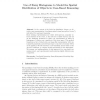Free Online Productivity Tools
i2Speak
i2Symbol
i2OCR
iTex2Img
iWeb2Print
iWeb2Shot
i2Type
iPdf2Split
iPdf2Merge
i2Bopomofo
i2Arabic
i2Style
i2Image
i2PDF
iLatex2Rtf
Sci2ools
AI
2008
Springer
2008
Springer
Use of Fuzzy Histograms to Model the Spatial Distribution of Objects in Case-Based Reasoning
Abstract. In the context of the RoboCup Simulation League, we describe a new representation of a software agent’s visual perception (“scene”), well suited for case-based reasoning. Most existing representations use either heterogeneous, manually selected features of the scene, or the raw list of visible objects, and use ad hoc similarity measures for CBR. Our representation is based on histograms of objects over a partition of the scene space. This method transforms a list of objects into an image-like representation with customizable granularity, and uses fuzzy logic to smoothen boundary effects of the partition. We also introduce a new similarity metric based on the Jaccard Coefficient, to compare scenes represented by such histograms. We present our implementation of this approach in a case-based reasoning project, and experimental results showing highly efficient scene comparison. Key words: Case Based Reasoning, Fuzzy Histograms, Knowledge Representation, Soccer Simulation
AI 2008 | Artificial Intelligence | Case-based Reasoning | Hoc Similarity Measures | RoboCup Simulation League |
| Added | 01 Jun 2010 |
| Updated | 01 Jun 2010 |
| Type | Conference |
| Year | 2008 |
| Where | AI |
| Authors | Alan Davoust, Michael W. Floyd, Babak Esfandiari |
Comments (0)

